University of British Columbia (UBC ) • Literature
Latest uploads for Literature at University of British Columbia (UBC ). Looking for Literature notes at University of British Columbia (UBC )? We have lots of notes, study guides and study notes available for Literature at University of British Columbia (UBC ).
-
7
- 0
-
1
Courses Literature at University of British Columbia (UBC )
Notes available for the following courses of Literature at University of British Columbia (UBC )
-
ENG255 1
-
ENG394 1
-
English217 1
-
English475 3
-
Writing350 1
Latest notes & summaries University of British Columbia (UBC ) • Literature
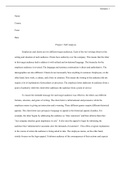
Employees and clients are two different target audiences. Each of the two writings observes the setting and situation of each audience. Clients have authority over the company. This means that the letter to this target audience had to address it with refined and invitational language. The hierarchy for the employee audience is reversed. The language and sentence construction is direct and authoritative. The demographics are also different. Clients do not necessarily have anything in common. Empl...
- Package deal
- Essay
- • 2 pages's •
-
University of British Columbia•Writing350
-
English 103 All Assignments• Byklausspader
Preview 1 out of 2 pages
Employees and clients are two different target audiences. Each of the two writings observes the setting and situation of each audience. Clients have authority over the company. This means that the letter to this target audience had to address it with refined and invitational language. The hierarchy for the employee audience is reversed. The language and sentence construction is direct and authoritative. The demographics are also different. Clients do not necessarily have anything in common. Empl...
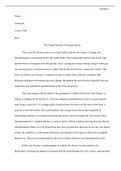
The novel The Metamorphosis by Franz Kafka explores the theme of change and transformation as insinuated by the title of the book. This relationship between the novels title and the theme is brought to life through the story’s protagonist Gregor Samsa. Gregor wakes up one morning from a troubled dream to realize that he has turned into a monstrous vermin. The story is a follow up of Gregor’s ordeal as he tries to come terms with new condition. But although undergoes tremendous physical chang...
- Package deal
- Essay
- • 4 pages's •
-
University of British Columbia•ENG394
-
English 103 All Assignments• Byklausspader
Preview 1 out of 4 pages
The novel The Metamorphosis by Franz Kafka explores the theme of change and transformation as insinuated by the title of the book. This relationship between the novels title and the theme is brought to life through the story’s protagonist Gregor Samsa. Gregor wakes up one morning from a troubled dream to realize that he has turned into a monstrous vermin. The story is a follow up of Gregor’s ordeal as he tries to come terms with new condition. But although undergoes tremendous physical chang...
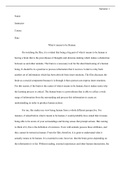
On watching the film, it is evident that being a big part of what it means to be human is having a brain that is the powerhouse of thoughts and decision-making which makes a distinction between us and other animals. The brain is a necessary tool for the ideal functioning of a human being. It should be in a position to process information that it receives I order to relay back another set of information which has been derived from inner emotions. The film discusses the brain as a crucial componen...
- Package deal
- Essay
- • 2 pages's •
-
University of British Columbia•ENG255
-
English 103 All Assignments• Byklausspader
Preview 1 out of 2 pages
On watching the film, it is evident that being a big part of what it means to be human is having a brain that is the powerhouse of thoughts and decision-making which makes a distinction between us and other animals. The brain is a necessary tool for the ideal functioning of a human being. It should be in a position to process information that it receives I order to relay back another set of information which has been derived from inner emotions. The film discusses the brain as a crucial componen...
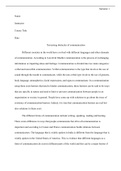
Different societies in the world have evolved with different languages and other elements of communication. According to Leavitt & Mueller communication is the process of exchanging information or imparting ideas and feelings. Communication is divided into two main categories: verbal and nonverbal communication. Verbal communication is the type that involves the use of sound through the mouth to communicate, while the non-verbal type involves the use of gestures, body language, atmospherics, fac...
- Essay
- • 5 pages's •
-
University of British Columbia•English217
Preview 2 out of 5 pages
Different societies in the world have evolved with different languages and other elements of communication. According to Leavitt & Mueller communication is the process of exchanging information or imparting ideas and feelings. Communication is divided into two main categories: verbal and nonverbal communication. Verbal communication is the type that involves the use of sound through the mouth to communicate, while the non-verbal type involves the use of gestures, body language, atmospherics, fac...
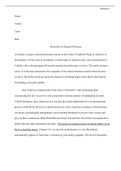
As literary concepts, dramatis personae emerge in the works of Vladimir Propp in reference to the tendency of fairy tales to incorporate a broad range of character types. One such persona in Collodi’s tale is the protagonist Pinocchio around which the story revolves. The author creates a series of events that characterize the escapades of his central character around which the story revolves. He further develops numerous characters including helpers and villains that help his storytelling as t...
- Essay
- • 3 pages's •
-
University of British Columbia•English475
Preview 1 out of 3 pages
As literary concepts, dramatis personae emerge in the works of Vladimir Propp in reference to the tendency of fairy tales to incorporate a broad range of character types. One such persona in Collodi’s tale is the protagonist Pinocchio around which the story revolves. The author creates a series of events that characterize the escapades of his central character around which the story revolves. He further develops numerous characters including helpers and villains that help his storytelling as t...
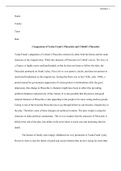
Yasha Frank’s adaptation of Collodi’s Pinocchio extensively alters both the theme and the main character of the original story. While the character of Pinocchio in Collodi’s novel, The Story of a Puppet, is highly active and hard headed, in that he does not listen or follow the rules, the Pinocchio portrayed on Frank’s play, Pinocchio is very passive, docile, and does not present so much hard headedness as the original one. Seeing that these was in late 1930s, early 1940s, a period marre...
- Essay
- • 2 pages's •
-
University of British Columbia•English475
Preview 1 out of 2 pages
Yasha Frank’s adaptation of Collodi’s Pinocchio extensively alters both the theme and the main character of the original story. While the character of Pinocchio in Collodi’s novel, The Story of a Puppet, is highly active and hard headed, in that he does not listen or follow the rules, the Pinocchio portrayed on Frank’s play, Pinocchio is very passive, docile, and does not present so much hard headedness as the original one. Seeing that these was in late 1930s, early 1940s, a period marre...
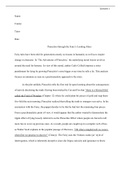
Pinocchio through the Fairy’s Looking Glass Fairy tales have been told for generations mostly as lessons in humanity as well as to inspire change in character. In ‘The Adventures of Pinocchio,’ the underlying moral lesson revolves around the need for honesty. In view of this moral, author Carlo Collodi imposes a strict punishment for lying by growing Pinocchio’s nose bigger every time he tells a lie. This analysis focuses on animism as seen in a psychoanalytic approach to the story. A...
- Essay
- • 5 pages's •
-
University of British Columbia•English475
Preview 2 out of 5 pages
Pinocchio through the Fairy’s Looking Glass Fairy tales have been told for generations mostly as lessons in humanity as well as to inspire change in character. In ‘The Adventures of Pinocchio,’ the underlying moral lesson revolves around the need for honesty. In view of this moral, author Carlo Collodi imposes a strict punishment for lying by growing Pinocchio’s nose bigger every time he tells a lie. This analysis focuses on animism as seen in a psychoanalytic approach to the story. A...
